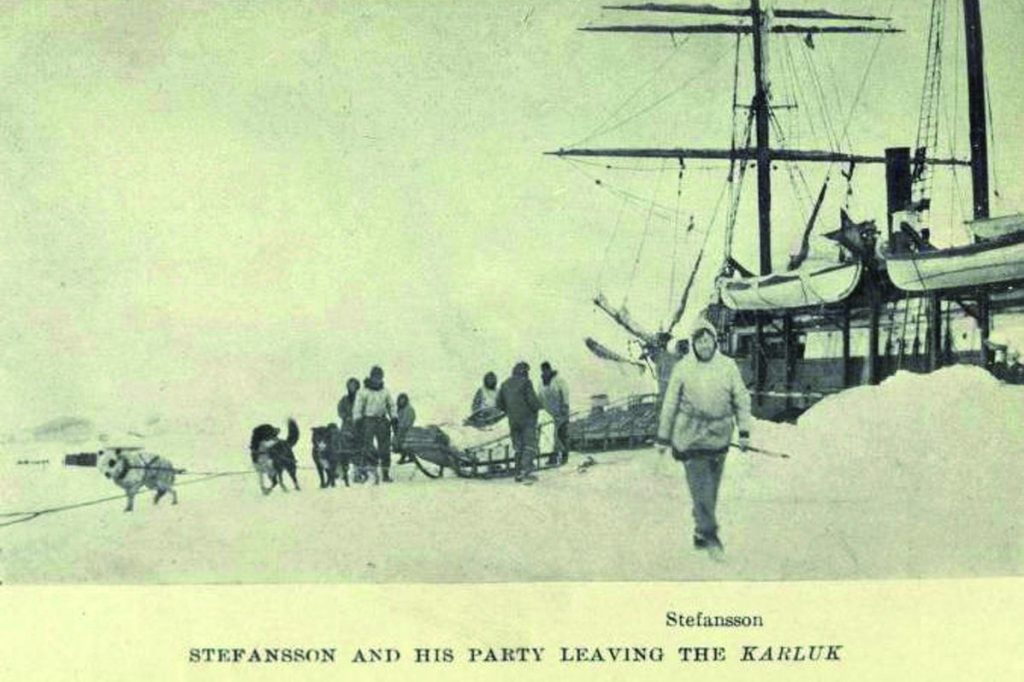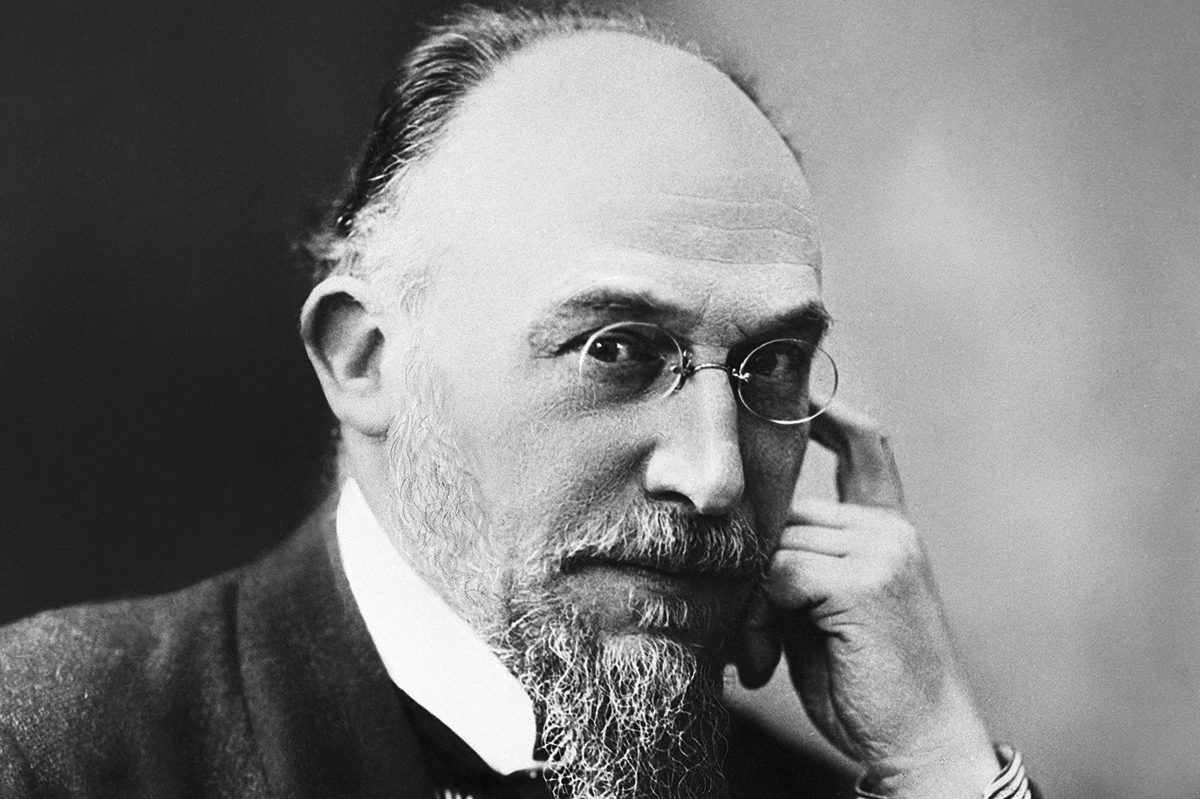The heroic age of polar exploration gave birth to epics as grand and as harsh as the landscapes in which they unfolded. And, as in all the best epics, their protagonists are often of interest not only for what they do, but also for who they are, or, in the case of the Arctic adventurer — “explorer” is too confining a word — Vilhjalmur Stefansson (1879-1962), who they pretend to be.
Stefansson is the “villain” of Buddy Levy’s Empire of Ice and Stone: The Disastrous and Heroic Voyage of the Karluk, a tale that reads like an unusually grim, remarkably gripping Edwardian imperial yarn. Among its features: grueling, dangerous journeys, astonishing feats of endurance, heroism, a shipwreck, iron self-discipline, appalling selfishness, terrible suffering, an amputation silently withstood, hallucinations, a possible murder, indispensable “natives,” class conflict, a cook overfond of laudanum, a doctor overfond of alcohol, soccer games on the ice, polar-bear attacks, polar bears attacked back (and eaten), a legendary lost tribe of “blond Eskimos,” great-power politics, a lovable kitten, a plucky dog, scientists, sailors and an injection of cocaine into someone’s eyes. From the corner of the afterlife that is still colored red, Rudyard Kipling, H. Rider Haggard and other canceled storytellers of empire will have appreciated this book, which is not only on message, but is also, sometimes amazingly, true.
Shortly before the Karluk of the disastrous and heroic voyage is about to begin its final descent beneath the ice in which it had been embedded, its captain, Robert Bartlett (1875-1946) placed a record of Chopin’s “Funeral March” on the Victrola and went up on deck:
“She’s going!” he yelled out, and one by one the seamen and crewmen and scientists came from the igloo and snow house and stood on the ice. They came as close as they could, watching Bartlett standing there alone. Then, with the notes of “Funeral March” carried by the Arctic winds, accompanied by the percussive sounds of ship timbers buckling and snapping, Bartlett waited until the rail was just even with the ice and he stepped off his ship.
That’s not something, I suspect, that Stefansson could have pulled off, but then he was not cut from Britannia’s weird cloth. Christened William (and, according to sources other than Levy, born Stephenson not Stefansson), he was the son of poor Icelandic immigrants to Canada. That could not be changed, even if his name(s) could. In all other respects, he had every intention of deciding for himself who he was or would be. To this end, it helped that he was clever, intellectually curious and hardworking, but what really gave him his edge was his talent to deceive and persuade as well as — to put it at its politest — a certain indifference. Levy never uses the term, but Stefansson was clearly a sociopath, a useful disorder for a man forever on the make. Guile, charm and brains took him to Harvard, and then luck lent a hand. An explorer, impressed by a paper Stefansson had written on the Norse discovery of Greenland, offered him a place on an expedition to Canada’s Arctic coast.
Levy does an excellent job of keeping what could be a chaotic story, with different protagonists scattered around the Arctic, smoothly sledding along. And he succeeds in combining mounting tension — who’s going to make it — with small details ranging from ice lore to the taste of seal that act as reiterative reminders of the strangeness, danger and beauty of the environment in which the Karluk had found itself.
One of those aboard the Karluk sees a moving icepack:
It was like being in some gigantic sculptor’s yard, stacked as far as the eye could see with glistening marble blocks cut in a million fantastic shapes.
By 1913, Stefansson had established enough credibility in Arctic circles to have talked himself into the job of heading and organizing the (first) Canadian Arctic Expedition, a mission of exploration and, if any previously unknown islands should be found, acquisition. There were warning signs even before the expedition set sail, such as Stefansson’s comments that success of the mission counted for more than the safety of those who manned it, or the selection of the Karluk as its flagship, a brigantine ill-equipped to handle High Arctic conditions had it been in decent shape (it wasn’t). Stefansson’s first choice of captain quit at the last minute, but was replaced by Bartlett, an Arctic veteran from Newfoundland rated by Admiral Peary (who had worked with him) as the best ice navigator in the world.
Bartlett managed to get the Karluk in reasonably good order in time, but that was about all in the expedition that was. Stefansson had been distracted and in a hurry. The expedition was simply not in a fit state to leave when it did. To be short of winter clothing was one rather obvious omission on an expedition to the far north. To remedy that gap, an Inupiaq seamstress was hired, and furs and skins were bought en route. She was still sewing even after the Karluk had been swallowed by the ice. Moreover, the wrong men and the wrong equipment were on the wrong ships (the expedition had swollen to three vessels). No plan had been made to deal with the possibility that these ships would become separated and thus fail to make the rendezvous where some of these problems could be resolved.
Winter came early that year. Before it could reach the rendezvous, the Karluk became embedded in ice that began to carry it further and further away, toward Siberia, although it was bound to crush the brigantine long before it got there. This was the moment that Stefansson took a party across the ice to hunt caribou onshore, even though the ship had no lack of fresh meat. Quite what he was thinking remains a mystery to some, although not to many on the Karluk, stuck on a ship stuck in the ice as the leader of their expedition made his way — they correctly assumed — to safety. Levy finds Stefansson’s explanation of his excursion to be “unsatisfactory.”
On the other hand, Stefansson’s departure left the infinitely more methodical Bartlett in charge. The captain carefully prepared for the moment when the ship would be destroyed, while doing what he could to delay it. When the time for Chopin was almost upon them, those aboard the Karluk were able to transfer to a well-equipped encampment on the ice. But that could only be a temporary solution. The next step was a miles-long trek across the Arctic ice plain to the nearest large island, but then what? Four preferred to take a different course. They did not survive, nor did an advance party that only reached a smaller, closer island.
The main group made it to Wrangel Island in early March 1914 (two months after the Karluk had sunk). Their resources were dwindling, they were far above the Arctic Circle and no one knew where they were. Their mood would not have been improved had they known that Stefansson, by now in Alaska, had advised that any effort to locate the Karluk or any survivors would be futile. And then he turned north again in an attempt to find Crocker Land, a landmass that Peary claimed to have seen (it doesn’t exist). Bartlett was more correct than he knew when he determined that he had no choice other than to go to Siberia to get help. Within weeks, accompanied by the formidable Inupiaq Kataktovik, he had set off once again across the ice.
It ought, by now, to come as no surprise that these two extraordinary men got to Siberia. With the assistance of the region’s indigenous Chukchi and then the Russians, the two were able to make their way back to North America, and Bartlett was able to arrange for the rescue in September of those still alive on Wrangel Island. None, with the possible exception of the Inupiaq among them, would have been able to on hang on much longer. In all, fourteen of those who stepped out onto the ice as the Karluk crumbled were to survive (eleven did not).
Their survival was in large part due to Bartlett, Levy’s “hero” (and deservedly so) even if two questions might be worth more examination. Bartlett did his best to make the Karluk fit for the role it had been assigned, but did he know enough about the other inadequacies in the preparations Stefansson had made to have had the responsibility to sound the alarm or even pull out of the expedition? But if he did, was it overridden by the call of the Arctic?
There can, however, be no doubt that Stefansson’s fundamental absence of concern for human life lay at the core of the Karluk’s tragedy. And as villains are said to do, he returned, if only metaphorically, to the scene of the “crime,” arranging a harebrained mission to colonize Wrangel Island—by then within Soviet borders—in 1921. None of the four men he dispatched returned alive. One of them, incredibly, was a survivor of the Karluk.
This article was originally published in The Spectator’s April 2023 World edition.





















